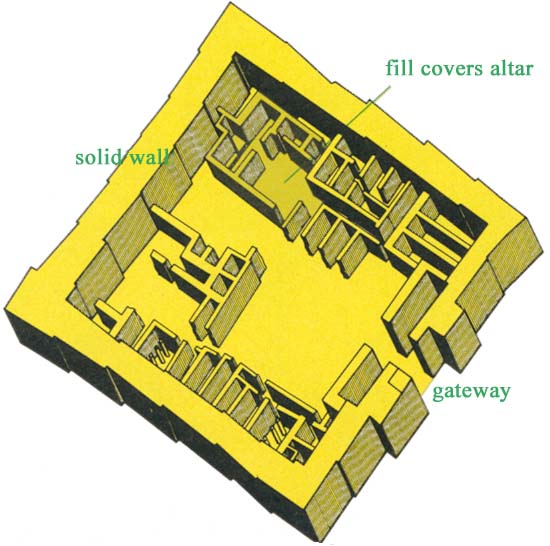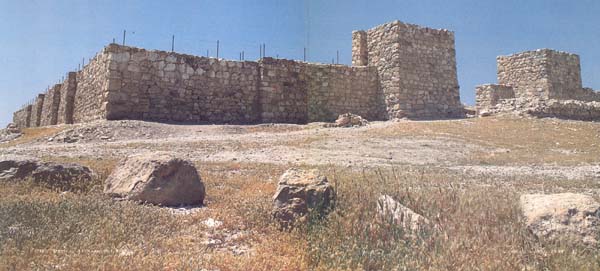
The Israelite fortress at Arad is unique in the Land of Israel. It’s the only site excavated with modern archaeological methods that contains a continuous archaeological record from the period of the Judges (c. 1200 B.C.) to the Babylonian destruction of the First Temple (580 B.C.). This distinction promises to make Arad the type-site for pottery chronology, especially in southern Israel, against which pottery from other sites can be confidently tested and dated. Not only is the pottery sequence continuous, but the timelines between the various strata during which the Israelite fortress was built and rebuilt are for the most part clear and can often be connected with well-known historical and datable events.
Arad is also special for other reasons. The Israelite fortress there was found to contain the only Israelite temple ever discovered in an archaeological excavation.
The excavation of the fortress also yielded a unique series of inscriptions. The inscriptions, written for the most part with ink on potsherds—called ostraca (singular, ostracon)—include political, administrative and sometimes even religious documents. Other sites have yielded ostraca collections—for example, the Lachish letters and the Samaria ostraca—but each of those collections belonged to only one major stratum and time period. At Arad the inscriptions span a period of 350 years and cover six different strata. In all, more than one hundred texts and fragments were recovered. Why at Arad? The answer is twofold, relating to where and to who.
The where is the Negeba—a place so dry, where rain falls so infrequently, that ink inscribed on potsherds and buried in the ground for 2,500 years is preserved.
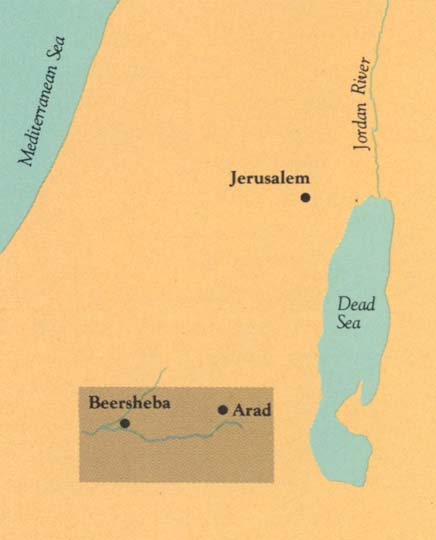

The who is a man named Yohanan Aharoni, the inspired leader of Tel Aviv University’s Institute of Archaeology and director of the excavation of the Israelite fortress at Arad. Aharoni died at the height of his career in 1976. He had excavated at Arad for five seasons between 1962 and 1967. At his death he had already published the inscriptions from Arad. The excavation materials were in an advanced state of preparation, but not yet completed. His colleagues, including the co-authors of this article, are completing the excavation report.
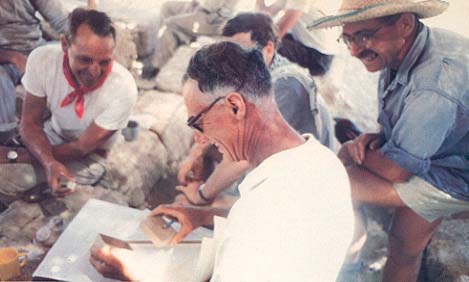
The recovery of the Arad inscriptions is largely the result of Aharoni’s insistence that each pottery sherd be dipped in water and examined before being scrubbed with a brush. As a result, many traces of writing were rescued that otherwise might have been obliterated before anyone noticed them.
Still a third reason why so many inscriptions were found at Arad is that practically all of the upper tell at Arad, on which the Israelite fortress was located, was excavated. The finding of an archive was therefore not left to blind chance.
Among the inscriptions was one mentioning the “Temple of Yahweh,” undoubtedly a reference to the Temple in Jerusalem. Others contain the names of known priestly families.
Arad is mentioned only three times in the Bible—and all three references are in connection with the Israelites’ entry into the Promised Land. In Numbers 21:1–3a we read:
“When the Canaanite, king of Arad, who dwelt in the Negeb, learned that Israel was coming by the way of the spies, he engaged Israel in battle and took some of them captive. Then Israel made a vow to the Lord and said, ‘If you deliver this people into our hand, we will proscribe their towns.’ The Lord heeded Israel’s plea and delivered up the Canaanites; and they and their cities were proscribed.”
Another passage in Numbers refers to “the Canaanite, king of Arad, who dwelt in the Negeb” (33:40). Finally, the king of Arad is listed in Joshua 12:14 as one of the kings Joshua defeated.
From the archaeological evidence, we know that there was a major urban center at Arad in Early Bronze Age I and II (c. 3000 to 2650 B.C.), but that Arad was destroyed and then abandoned long before the Israelite Exodus from Egypt and entry into Canaan. When Arad was resettled, about 1,500 years later, after 1200 B.C., the new inhabitants chose to build on the eastern hill, the highest point of the site. This new site later became Israelite Arad, and the location of the fortress we shall be examining.
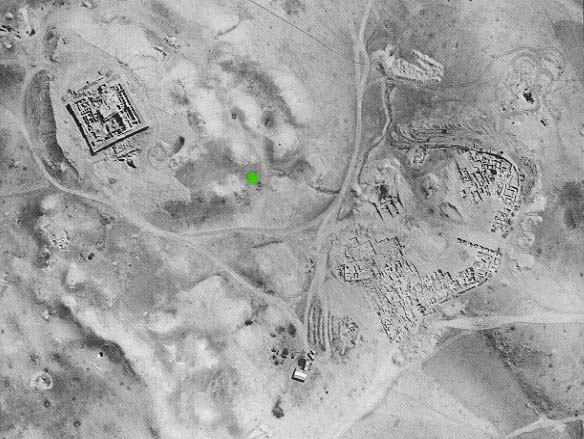
But these hilltop settlers who constructed an unwalled village sometime after 1200 B.C. (stratum XII) were not Israelites. Who, then, were they? Our educated guess is that they were Kenites, descendants of Moses’ father-in-law (Judges 1:16). The Kenites, traditionally associated with metalworking, apparently lived in the eastern Negeb. In the Biblical Negeb, the Amalekites were the dominant ethnic element (Numbers 13:29). Their relationship with the Kenites is unclear. The Bible credits the Amalekites with preventing Israelite penetration into the Promised Land from the south (1 Samuel 15:21); they were therefore Israel’s sworn enemy forever (Deuteronomy 25:17). The Kenites, however, had showed kindness to the Israelites when they left Egypt, so they were not regarded with the same animosity as the Amalekites. The settlement of the area around Arad by Kenites rather than Amalekites is reflected in the Bible’s reference to the “Negeb of the Kenites” (1 Samuel 27:10; Judges 1:16).

Little was found of this “Kenite” village at Arad—a few dwellings, some silos for storage, some pottery. At one point, a low stone fence, hardly sufficient for defense, had been built around the top of the hill. Two finds are of special significance. In the center of the village was an open courtyard with a circular platform nearly 20 feet in diameter and also a rectangular platform about 7 feet long by 7 feet wide. Both platforms may have been altars. It is especially likely that the rectangular platform was an altar because here, centuries later, an Israelite altar was built, reflecting, as is so common in the ancient Near East, a continuity of cultic traditions despite an ethnic discontinuity.
Beginning in the tenth century B.C., and ending in the sixth century B.C., six successive Israelite fortresses were built or rebuilt on the hill corresponding to strata XI (the earliest) through VI (the latest). We call them Israelite fortresses even though, after Solomon’s death, Israel was divided into the kingdom of Israel in the north and the kingdom of Judah in the south. After this split, Arad was part of the kingdom of Judah.
Each of the six Israelite fortresses was essentially the same shape—square, about 160 feet on each side, basically covering the hilltop.
The first Israelite fortress, the fortress of stratum XI, was probably built by King Solomon (c. 970–930 B.C.), although we can date its destruction more precisely than its construction. A fiery conflagration destroyed the first fortress (XI) toward the end of the tenth century B.C. We know that five years after King Solomon’s death the Egyptian Pharaoh Sheshonq (Shishak in the Bible, 1 Kings 14:25–28; 2 Chronicles 12:2–12), led a destructive military foray into Judah and Israel, both of which had been weakened by internal dissension. In his victory inscription at the Temple of Karnak at Thebes, Shishak claims to have destroyed two places named Arad, both described as fortresses.1 One of these was undoubtedly the Israelite fortress of stratum XI, Solomon’s fortress, so we can date its destruction to 926 B.C.
Even before King Solomon, King David organized the Negeb into a unified administrative entity (2 Samuel 24:7). Under King Solomon, the commercial trade routes between the Philistine coast and the port of Elath grew in importance. The establishment of fortified centers like Arad strengthened Solomon’s defenses in the south and facilitated close supervision of the roads from Philistia to Elath, thereby giving King Solomon exclusive control of them. Pharaoh Shishak’s campaign in the Negeb was evidently aimed at breaking that monopoly.
To construct his fortress at Arad, Solomon first created a flat, buildable surface with fill. The fill’s depth varied from 1 to 3 feet. The basic outside wall of the fortress was designed according to the casemate pattern: Two parallel walls enclosed a space in between. On the fort’s eastern side, the space between the two walls was exceptionally wide, as much as 16 feet. Interior walls perpendicular to the parallel walls subdivided the space into rooms—forming a type of structure called a casemate wall.
The gateway to Israelite fortress XI was in the northeastern corner. It was a narrow passageway, only 5 feet wide, extending out from the eastern wall about 22 feet. On the north side of this passage was a tower with a room at the bottom. The entryway of the gate led to a room within the casemate wall. From there one entered the fortress itself.
Other towers protruded from the walls at the corners and on the northern and western sides of the fortress. These towers permitted flanking fire on any attacker who might get close to the wall and whom it would otherwise be difficult to hit. But in the end, this fortress was not strong enough to withstand the fire power of Pharaoh Shishak, who conquered and then burned it.
In the ninth century, the fortress Shishak had destroyed was rebuilt. A solid wall replaced the casemate system. Remains of some casemate rooms were preserved; they were filled in with earth and stones to serve as foundations for the new wall. The towers Solomon had built were not restored. Moreover, the outer face of the wall was not built in a straight line, as before, but was staggered at small angles in a sawtooth pattern. The purpose for this angling was not military, since the corners did not project sufficiently to permit enfilading fire. The motivation was evidently to gain stability by building a series of cross segments inside the wall, perpendicular to it. Perhaps the angles also created a series of vertical shadows, enhancing the impression of height and providing a psychological deterrent. In any case, the builders did not depend on this alone, but gave their solid wall an average thickness of over 12 feet.
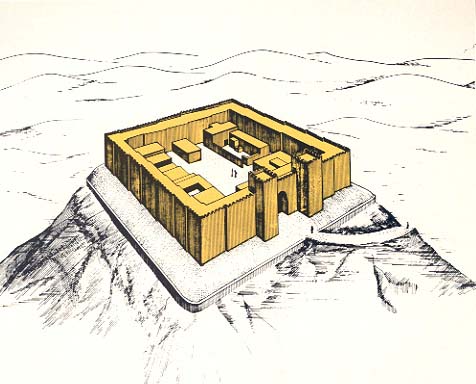
The problem of defending the area at the base of the wall was probably solved by building balconies with slots in their floors, enabling the Israelites to rain a fusillade of fire on the enemy below.
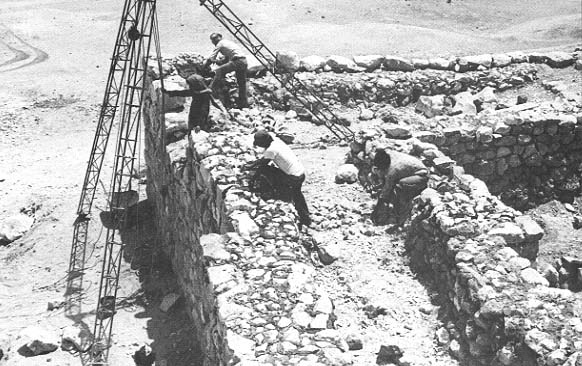
In addition, a new gateway was built in the center of the eastern wall. This gate was defended by two massive towers, one erected on each side of the entryway. Access to the gate from inside the fortress was between two walls that took a turn at either end to attach themselves to the rear of the towers. As a result, the defenders enjoyed a direct field of fire on anyone trying to force the entrance; the gate enclosure became a deathtrap to the attacker.
Another innovation in the fortification system was the strengthening of the foundations of the fortress by the addition of a sloping earthen rampart supported at the base by a revetment wall. Portions of this stone revetment wall were found 35 feet down the slope from the western side of the fort, which gives some idea of how big the earthen rampart must have been. The earthen rampart was added to prevent both natural erosion of the foundations and enemy attempts to undermine the fortifications. The steep slope (the glacis) created difficulty for attackers and appreciably reduced the blind area below the wall.
The fortress planners also gave their attention at this stage to improving the inhabitants’ water supply so the fort could withstand siege for a longer period. A channel about one foot wide was cut in the bedrock. This channel ran under the western revetment wall, under the earthen rampart, and under the fortress wall itself, for a length of 80 feet. Inside the fortress the channel led to two well-plastered underground cisterns, quarried in the bedrock. Outside the fortress, water was collected from a well (see “The Well at Arad,” in this issue). This water was transferred to the fortress in containers of various types; it was poured into the channel and ran into the water cisterns. Thus the risky chore of hauling water around to the gate on the opposite side of the fortress was eliminated. The channel was sloped inward to permit the water to run into the cisterns. The cisterns held about 9,000 cubic feet (250 cubic meters); stain lines on the plaster inside the cisterns testified to the fact that they had been actively used.
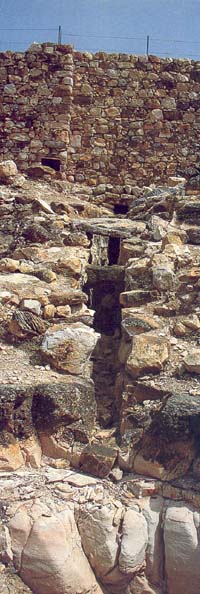
Who built Israelite fortress X following the destruction of Israelite fortress XI by Shishak? It may have been the work of King Asa (2 Chronicles 14:4–6; 1 Kings 15:23) at the end of the tenth or the beginning of the ninth century B.C. (between 910 and 870). On the other hand, the son of Asa, Jehoshaphat (870–848 B.C.), is depicted as the initiator of extensive building projects (2 Chronicles 17:1–2, 13; 21:3). He is also described as the master of the route to Elath (1 Kings 22:47–48). To exact tribute from the Philistines and the Arabs (2 Chronicles 17:10–12), Jehoshaphat would have had to control caravan traffic. This would have required maintaining a strong military presence in the Negeb, so it may well be Jehoshaphat who constructed Israelite fortress X.
Fortress X was probably the longest-lived of all six Israelite fortresses, as evidenced by the pottery.
It is difficult to tell precisely the circumstances under which this occupation came to an end. It probably happened during the reign of Jehoram (848–841 B.C.). At that time, Edom seceded from Judah (2 Chronicles 21:8, 10), thus weakening Judah’s control of the Negeb. This weakness was exploited by the Philistines and the Arabs, who invaded Judah and plundered the royal house (2 Chronicles 21:16–17). Israelite fortress X was probably destroyed in this military campaign, about 842 B.C.b
Israelite fortress IX was simply a rebuild with minor changes. It represents renewed Judean control of the Negeb and the trade routes from Arabia to the Mediterranean coast during the eighth century B.C. No doubt this was accomplished by Uzziah (also known as Azariah), who not only rebuilt Elath in or after 767 B.C. (2 Kings 14:22; 2 Chronicles 26:2), but also regained the upper hand over the Philistines and the Arabs (2 Chronicles 26:7–8).
The enemies of Judah launched a counterattack about 735–732 B.C., during the reign of Ahaz. Elath was retaken by the Edomites (2 Kings 16:6), who then coordinated an attack with the Philistines against the towns of the Shephelah and the Negeb of Judah (2 Chronicles 28:17–18). This attack on the Negeb must have included the conquest and destruction of Israelite fortress IX.
In the destruction debris of Israelite fortress IX, sherds comprising about half a bowl were found. On the inside of the bowl the name Arad was incised several times (Inscription 99), thus removing any doubt that this site was indeed ancient Arad. (The name Arad also appears on a small ostracon found in Israelite fortress VIII [Inscription 48] and on a major inscription from Israelite fortress VI [Inscription 24].)
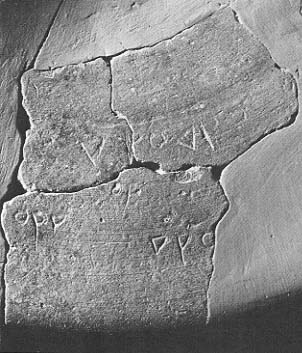
Israelite fortress VIII was a rebuild of fortress IX by King Hezekiah in the late eighth century B.C. It was, no doubt, part of Hezekiah’s preparations for his rebellion against Assyria (2 Chronicles 32:27ff). He similarly fortified Beer-Sheba at the other end of the northern valley of the Negeb.
The stratum VIII fortress was destroyed in the late eighth century B.C. by the Assyrian ruler Sennacherib, or perhaps by his Edomite and Philistine allies.c
In the course of the destruction of Israelite fortress VIII, appreciable segments of the solid wall were severely damaged. To avoid the expense and effort of dismantling the entire wall and rebuilding it, the planners of Israelite fortress VII inserted an inner wall at a distance of six feet from the foundations of the former wall. This new wall can be traced all along the inside of the southern wall and in parts of the eastern and northern walls of the fortress. An interesting combination was thus created between the solid and the casemate methods of fortification. By adding the inner wall, the dwelling units on the southern side were divided in two. At the same time, the western side of the fort was strengthened by the addition of a projecting tower at the middle of the western wall.
Israelite fortress VII was not rebuilt until the latter part of the seventh century B.C. The reason was simple: At the end of the eighth century, Sennacherib, king of Assyria had devastated Judah. He had even laid siege—though unsuccessfully (2 Kings 18:13–19:36; 2 Chronicles 32:1–21; Isaiah 36:1–37:38)—to Jerusalem. By his own account, which survives in cuneiform records, he destroyed 46 Judean cities. Sennacherib took great portions of Judah’s territory and gave them to the Philistines. During the entire first half of the seventh century B.C., there was no chance for Judah to rebuild her forts in the Negeb.
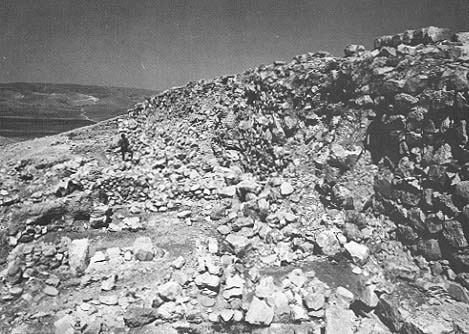
In 687 B.C. Manasseh came to Judah’s throne, after having ruled for a decade as co-regent with his father Hezekiah. Manasseh sought to improve Judah’s political and economic status by strengthening ties with her immediate neighbors, especially the Phoenicians in the north and perhaps even with the Arabs in the south. This he did by introducing his neighbors’ cults and worship into the local shrines of Judahd (2 Kings 21:3; cf. 1 Kings 16:31). There is no sign that Judah’s control over the Negeb routes was restored, however. Quite the contrary; the Assyrians took measures to assure their own control over the whole Levantine coast, with a view to a future conquest of Egypt.
The Assyrians needed the support of the Arabs for their attempted invasion of Egypt in 673 B.C. Although they failed in their first try, two years later they gained control of Lower Egypt. The assistance rendered by the Arabs in this campaign is stressed in surviving Assyrian records of Esarhaddon, the Assyrian monarch;2 obviously no invasion of Egypt would have been at all possible without Arab support. There can be no question but that the trade routes from Arabia across the Negeb to the Philistine coast were in the hands of the Arabs, the arch-rivals of Judah (2 Chronicles 21:16; 26:7–8). This situation continued until 669 B.C., when Esarhaddon started on another campaign to Egypt; however, he died on the way.
During the reign of the next Assyrian king, Asshurbanipal, the pendulum of power began to swing away from Assyria. Psammeticus 1, a former vassal of Assyria in the Egyptian delta, managed to unite all of Egypt by about 656 B.C. From 650 to 648 the Assyrian king and his brother, ruler of Babylon, fought a war. The Arabs and Phoenicians supported the brother and shared his defeat. Manasseh was arrested and taken to Babylon (2 Chronicles 33:11–17). At Babylon, Manasseh was given a new lease on life by Asshurbanipal (c. 648 B.C.) and was sent back to Judah. There he broke all his ties with his rebellious neighbors by cleansing Judah of its foreign cults. At Jerusalem, he built a wall to strengthen its defenses, and he restored commanders to the fortresses of Judah. It would seem that Asshurbanipal had decided to trust Manasseh and to return him to a key position vis-à-vis the Arabs in the south and other rebellious states that had disappointed him. Just how much Manasseh could have achieved in the last six years of his reign (until 642 B.C.) is uncertain. In 641 B.C. the child-king Josiah ascended the throne of Judah (2 Kings 21:24–22:1; 2 Chronicles 33:25–34:1). With the Arabs in disgrace, Judah must have regained the franchise to control the Negeb trade routes. By 622 Josiah had the military and fiscal base to aspire to local regional domination (2 Chronicles 34:9), while the Assyrian Empire was on the road to dissolution.
Therefore, the rebuilding of the fortress, Israelite fortress VII, may be ascribed to the second half of the seventh century B.C., either at the end of Manasseh’s reign or under Josiah, who built new fortified settlements in the Negeb, as we know from other excavations.
In 605 B.C., the Assyrians were defeated by the Babylonians at Carchemish, and Babylon then became the dominant world power. Not long after, she began to punish Judah. The final destruction came in 587 B.C. But Nebuchadnezzar had made another, earlier campaign to Jerusalem in 597 B.C. Israelite fortress VII was probably destroyed in a softening-up operation by Nebuchadnezzar in preparation for that campaign of 597 B.C. (2 Kings 24:1–2; Jeremiah 13:18–19).
It is likely that the last Judean fortress at Arad, fortress VI, was built in the fourth year of Zedekiah’s reign, 594 or 593 B.C., about three years after this destruction of the previous fortress by Nebuchadnezzar. Israelite fortress VI was planned along new lines, using the solid wall only as a deep foundation. A casemate system was constructed on the ruins of the previous fortresses; it consisted of two parallel walls with a space in between. On the northwestern and southwestern corners were projecting towers. Midway along the western side was a rectangular tower.

The fortified gate of the former strata was not rebuilt; instead, the entry to the fortress was moved over to the northern side. It was a simple opening, six feet wide, inserted between two of the casemates.
Fortress VI was probably destroyed in the Edomite invasion of the Negeb at the time of the Babylonian conquest of Judah (Obadiah 10–14; Psalm 137:7).
Until now, we have said nothing of the interior of these fortresses. The most fascinating interior feature was a unique Israelite temple dedicated to Yahweh—the only temple dedicated to the Hebrew God ever found in an archaeological excavation. But before discussing the temple, let us mention the reason for a large gap in our information concerning the interior of the fortresses.
In the Hellenistic period (third to second centuries B.C.) a new fort was built on the site, smaller than before, but with a massive square tower that covered nearly half of what had been the interior of the earlier Israelite fortresses. This huge Hellenistic tower measured about 60 feet on each side. It is unique at Arad in that its builders founded it on bedrock after digging out all the previous occupation deposits on their building site. That is why the plan of this tower appears on the plans of all six Israelite fortresses—not to indicate the Hellenistic tower but to indicate the absence of any other remains in that area. We simply don’t know what was there before the Hellenistic tower.
Fortunately, this Hellenistic tower did not destroy what must have been the most important building complex within the Israelite fortress—the temple to Yahweh. Moreover, this temple goes back to the first Israelite fortress at Arad, the time of King Solomon in the tenth century B.C.
The temple is located in the northwestern corner of the interior of the fortress, near the site of the cultic center of the Kenite settlement at the time of the Judges. The Main Hall (Hekhal or Holy Place) of the temple consisted of a broad-room, so called because it is oriented on the broad side. The entrance to the room is on the long wall, rather than on the short wall. Opposite the entrance is a niche that projects out from the back wall and represents the Holy of Holies (Debir).
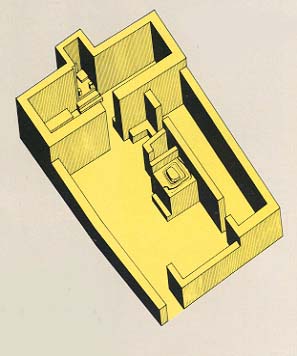
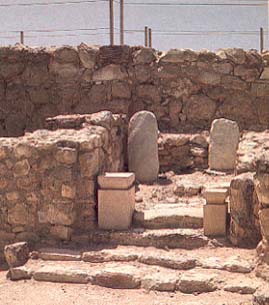
In front of the Main Hall was a comparatively large courtyard, over 30 feet square, enclosed by a wall and paved with small wadie stones. In the center of the courtyard stood a large sacrificial altar.
Everyone is naturally curious to compare the plan of the Arad temple with the plan of the nearly contemporaneous temple Solomon built in Jerusalem.
Such a comparison immediately demonstrates a fundamental difference, especially with regard to the Main Hall. At Arad this was a broad-room, while the corresponding room in the Solomonic Jerusalem Temple was clearly a long-room. Solomon sought to give his Jerusalem Temple a distinct character by borrowing the plan common in north Syria (and perhaps also in Phoenicia), based primarily on the megaron-type longroom. At Arad, however, the structure apparently utilized the broad-room, which was part of the standard “four-room house” commonly encountered in the Israelite period; “four-room houses” consisted of a broad-room with three long-rooms extending from it perpendicularly. Thus, the broad-room temple derived directly from Israelite domestic architecture. The Jerusalem Temple, on the other hand, looked to foreign cultic models.
It is worth noting that these two variations in temple layout were suited to their respective functions: The broad-room at Arad permitted those entering the courtyard a closer relationship to the Holy of Holies; this plan suited the temple’s function as a popular shrine. The long-room temple in Jerusalem kept the crowds at a distance from the symbols of the divine presence, which suited its function as a royal temple. In the Holy of Holies in the Jerusalem Temple, the Ark of the Covenant found its permanent home.
The Holy of Holies at the Arad temple was approached by two steps. At the entrance to the Holy of Holies were two small limestone incense altars. Within the Holy of Holies, on a small platform, was a smooth stele, or standing stone. What, if anything, was originally painted or inscribed on this stele we have no way of knowing. On either side of the Holy of Holies, on the wall of the Main Hall, were plaster-covered benches on which offerings could be placed.
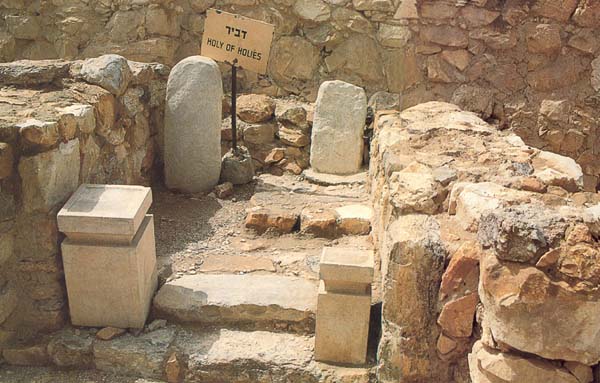
The reader will recall that Israelite fortress XI was destroyed by Pharaoh Shishak about 925 B.C. When the fortress was rebuilt, the temple was also rebuilt, although with some alterations. The Main Hall of the temple was made even broader by adding about two feet in the north. The location of the Holy of Holies was not changed, so the northern addition made the room somewhat lopsided—the Holy of Holies was no longer in the middle of the back wall. The addition to the Main Hall on the north was also carried into the courtyard; this produced a long-room on the northern side of the courtyard, which provided storage space for ritual vessels and offerings.
The large sacrificial altar in the courtyard was rebuilt directly over the old sacrificial altar, but slightly to the north of its predecessor. The remains of the earlier altar served as a step at the foot of the new altar. This new sacrificial altar measured exactly “five cubits long and five cubits broad,” the measurements of the tabernacle altar, as described in Exodus 27:1. Moreover, this new altar was made of unworked stones, as required by Exodus 20:22: “If you make for me an altar of stones, do not build it of hewn stones; for by wielding your tool upon them you have profaned them.”
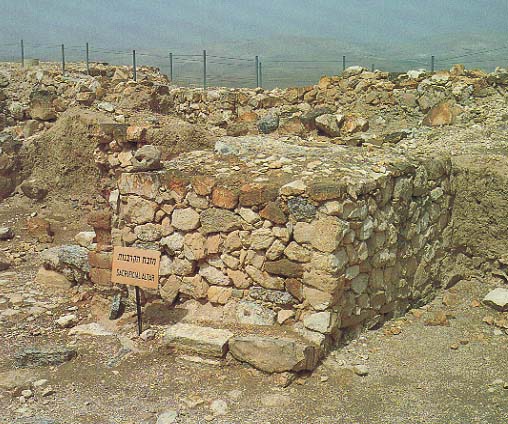
The unhewn stones of the Arad sacrificial altar in the temple courtyard were laid in a mud base. Whether or not there were horns at the corners of this altar, we do not know. Perhaps they were fashioned from plaster or wood and thus are not preserved. On top of the altar a large flint slab with plastered channels collected the blood and fat from the sacrifices. A metal rack probably held the coals on which the burnt offerings were laid; soot stains on some ashlar stones of a sacrificial altar at Beer-Sheba indicated that it had had such a rack. Similar evidence was not preserved at the Arad altar, however.
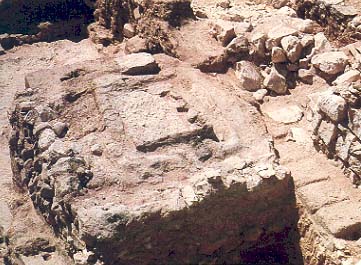
In a small room adjacent to the sacrificial altar on the west, excavators found a red-slip incense burner. It was made in two parts: a high, hollow base topped by leaves, and a deep small bowl, made to fit onto the stand and decorated at the base and rim with downturned leaves.
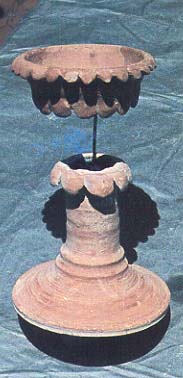
Two shallow bowls, found on the step at the foot of the sacrificial altar, bore inscriptions. The inscriptions were the same and consisted of two Hebrew letters qop and kaf. This is evidently an abbreviation for qo
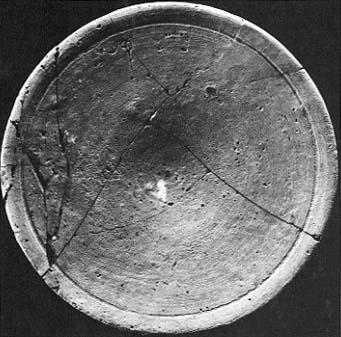
In Israelite fortress IX (early eighth century) the temple remained the same, but the rooms around the courtyard were reorganized by subdividing areas and creating additional rooms. As a result, the open space of the courtyard was appreciably reduced, suggesting some modifications in the nature of the ritual practiced there. During the offering of sacrifices on the altar, there was room for only a few people other than the officiating priests. Moreover, the entrance to the courtyard was shifted to the southeast corner. Opposite this new entrance was a stone installation, forming an elliptical basin on the inside. Perhaps a metal tub was originally placed within this basin to hold water; the installation stands where one would expect the laver for priestly ablutions.
In this stratum, a beautiful small bronze figurine of a resting lion was found beside the sacrificial altar.

In Israelite fortress VIII, the sacrificial altar was abolished. The courtyard of the temple was covered with a fill about three feet thick, which completely covered the altar. The adjacent stone basin also went out of use, and the entire courtyard became an open, level area. The altar of previous strata and the stone installation were found when we excavated under this fill, as were the two inscribed bowls mentioned above.
The temple itself, unlike the sacrificial altar, continued to exist in Israelite fortress VIII. Indeed, the temple wall of the hall to the north of the Holy of Holies was doubled in width. Two additional structures were built (partly over the previous courtyard), evidently to serve as stores for the temple. In a room beside the Holy of Holies, several important ostraca were found. Several other ostraca that originated with those discovered in this room were found in the debris thrown out of the fort on the slope nearby. In all there were eight ostraca. On each ostracon was inscribed a single name, either of an individual or a family. Two of these names are known to us from the Bible as members of the priestly cadre of Judah, Meremoth and Pashhur (Ezra 8:33; 1 Chronicles 9:12). Others, such as Eshiyahu and Netanyahu are Yahwistic; that is, they contain a linguistic element (yahu) corresponding to the Hebrew God Yahweh. All this is additional evidence that this was indeed an Israelite temple dedicated to Yahweh. At least some of these ostraca apparently had to do with the casting of lots for assigning duties in the temple and may have been used in setting up the duty roster.
The base of a burnished bowl from a room on the eastern side of the temple courtyard was inscribed with administrative entries including references to payments from or allotments to groups such as “the sons of Korah” and “the sons of Bezal(el),” also well known from the Bible as priestly families (Psalm 42:1; Exodus 31:1–11). From these strong Biblical associations, there can be no doubt that the officiants at the temple were Israelites of the recognized priestly and levitical orders, and that the temple itself was dedicated to the worship of the Israelite God Yahweh.
But why was the sacrificial altar in the courtyard of the Arad temple abolished? The abolition of this altar was no doubt associated with the religious reforms carried out by Hezekiah beginning in 715 B.C.
Hezekiah’s abolition of sacrifical altars that might be thought to compete with the central altar in Jerusalem is exceedingly well documented in the Bible. In 701 B.C., when one of Sennacherib’s officers was sent to urge the besieged citizens of Jerusalem to abandon Hezekiah and surrender to Sennacherib, the Assyrian officer taunted the Jerusalemites with these words:
“Hezekiah is seducing you to a death of hunger and thirst, saying ‘The Lord our God will save us from the king of Assyria.’ But is not Hezekiah the one who removed His shrines and His altars and commanded the people of Judah and Jerusalem saying, ‘Before this one altar you shall prostrate yourselves, and upon it make your burnt offerings’?” (2 Chronicles 32:11–12)
The same speech is found in 2 Kings 18:22 in slightly different words:
“And if you tell me that you are relying on the Lord your God, He is the very one whose shrines and altars Hezekiah did away with, telling Judah and Jerusalem, ‘You must worship only at this altar in Jerusalem’.”
(This speech is again repeated in Isaiah 36:7.)
When Hezekiah carried out his religious reforms, the northern kingdom of Israel had already fallen to the Assyrians (in 721 B.C.) and was no more. Hezekiah tried to unite the northern tribes with those of the south in their allegiance to Jerusalem as the sole religious center.
Hezekiah sent couriers throughout “all Israel and Judah” to proclaim the message.
“O you Israelites! Return to the Lord God of your fathers, Abraham, Isaac, and Israel, and He will return to the remnant of you who escaped from the hand of the kings of Assyria. Do not be like your fathers and brothers who trespassed against the Lord God of their fathers and he turned them into a horror, as you see. Now do not be stiffnecked like your fathers; submit yourselves to the Lord and come to His Sanctuary, which He consecrated forever, and serve the Lord your God so that His anger may turn back from you” (2 Chronicles 30:6–8).
The northerners, like the southerners, were invited by Hezekiah to join in the great Passover celebration to be held in Jerusalem. Hezekiah apparently sought to prove to the northern Israelites that he was giving them treatment equal to that of the residents of Judah. He therefore felt it was politic to order the abolition of separate cults in the cities and fortresses of Judah, just as he was demanding that the northerners should give up their shrines in Samaria, Bethel and elsewhere. This then is the religious and historical background behind the archaeological evidence at Arad showing the abandonment and covering over of the sacrificial altar in the temple courtyard. Incidentally, this is also the reason for the dismantling of the sacrificial altar discovered in the excavations at Beer-Sheba.
In the next stratum (Israelite fortress VII), the temple itself was abolished—in connection with another famous religious reform, this time by King Josiah in the late seventh century. We may read at length of Josiah’s religious reform in 2 Kings 23. Specifically, we learn that “he brought all the priests from the towns of Judah [to Jerusalem] and defiled the shrines where the priests had been making offerings—from Geba to Beer-Sheba” (2 Kings 23:8).
Although the temple at Arad was abolished, this was done with a certain reverence. Out of respect for their sanctity, the two incense altars that stood on the steps at the front of the Holy of Holies inside the temple were laid on their sides and covered with a layer of earth that completely concealed all traces of the former shrine. Over this fill were constructed thinner walls of what appears to have been a dwelling unit. And so the temple of Yahweh at Arad came to an end.
In the stratum of Israelite fortress VI, just before the Babylonian destruction of Jerusalem, excavators found an ostracon that contained a reference to “the house of Yahweh.” This can refer only to the Temple in Jerusalem. The Arad temple had already been abolished. This mention of the Jerusalem Temple points to a connection, however, between the officialdom at Arad and the religious center in Jerusalem, somewhat reminiscent of the levitical administrative role “for all the work of Yahweh and all the service of the king … everything pertaining to god and the king” (1 Chronicles 26:30, 32).
MLA Citation
Footnotes
We use the Biblical spelling of Negeb (rather than Negev). Negeb refers to the Valley of Beer-Sheba (also the Biblical spelling; see map) where ancient Arad is located. Today the name Negev is used to designate the entire southern part of Israel.
An alternate date would be around 813 B.C. in the reign of Jehoash (Joash), when Judah was hard hit by Hazael, king of Damascus (2 Kings 12:17ff; 2 Chronicles 24:23–26). Judah’s southern enemies might have taken advantage of this situation, perhaps in consort with Hazael. But it is strange that the Bible is silent about any invasion of the south at this time. Miriam Aharoni dates the destruction of stratum X to the first quarter of the eighth century B.C.
Stratum VIII at Arad was destroyed at the same time as stratum III at Lachish. The Lachish destruction was commemorated in the famous Assyrian reliefs in Sennacherib’s palace depicting the siege and conquest of Lachish (see “Destruction of Judean Fortress Portrayed in Dramatic Eighth-Century B.C. Pictures,” BAR 10:02).
A wadi is a dry river bed or small river common in Israel and the surrounding regions. The American equivalent would be “arroyo.”
For a similar inscription see André Lemaire, “Probable Head of Priestly Scepter from Solomon’s Temple Surfaces in Jerusalem,” BAR 10:01.
Endnotes
In Shishak’s inscription, the Egyptian scribe defines the two Arads by the term hqrm, “fortress enclosures.” Two scholars, Martin Noth and Benjamin Mazar, long ago had seen that the Egyptian spelling represented the equivalent of later Aramaic h
James B. Pritchard, Ancient Near Eastern Texts (Princeton, NJ: Princeton University Press, 1969), p. 292.
Frank Moore Cross, who also made reference to the supposed confusion in the stratigraphy at Arad, suggested that the second letter was not kaf but a Phoenician shin of the sixth century B.C. On one of the bowls, the central stroke is so long as to preclude any association with a Phoenician shin; therefore, we reject his paleographic argument out of hand. Furthermore, those bowls were buried beneath a fill of stratum IX which itself was sealed by floors of the later strata. The stratigraphy here is absolutely certain and in no way confused.





